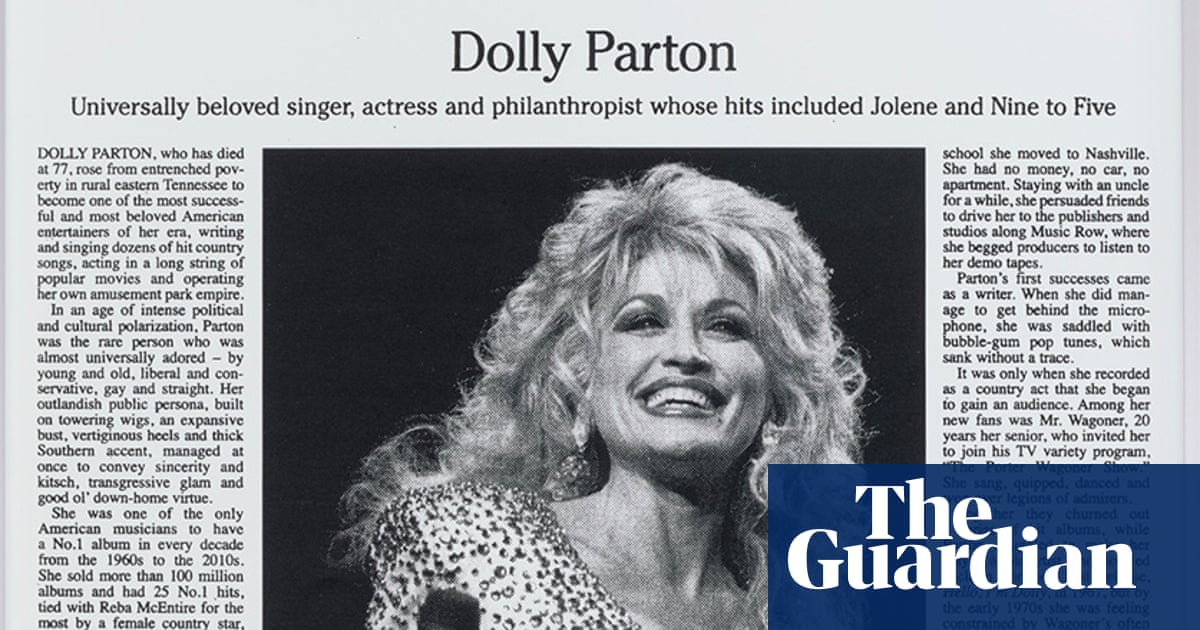
In the world of Adam McEwen, Dolly Parton is dead. Don’t worry, the much-loved singer and philanthropist is still very much with us, as are the other subjects of the British artist’s painfully accurate obituaries, including Lewis Hamilton, Greta Thunberg and Grace Jones. He puts the lives of the famous and admired into faux newspaper clippings, prints them on a large scale, and they are now to be seen hanging in a new London exhibition.
“The obituary is a narrative of decision-making: in 1984 she did this, in 87 she did that. The person is creating a story,” McEwen explains from his home in New York. “We all do that all day long: we decide to have a coffee or a cup of tea – these are decisions based on the question of what I should do to make my life more like I want it to be. Maybe that’s not unlike making an artwork. You’re in control, even if you don’t feel in control.”
McEwen, whose work also includes sculpture, signmaking and pen drawings, started incorporating obituaries into his art more than 20 years ago. His late teenage years had been overshadowed by the sudden death of his father, the folk musician and artist Rory McEwen, and he felt stuck in a rut working as a real obituarist at the Daily Telegraph in London.
“I was an artist out of art school and by chance a friend had this job: you can do it part-time, get in at 10am and the pay wasn’t so bad, but it didn’t make me feel I was on the right track,” he says. “You’re reading about people who have done stuff, and here is you, not really doing what you want to do. My memory is that I was in a cage that I couldn’t get out of. I wasn’t making art that I liked; I was basically failing and it was painful.”
He had however been invited to take part in a small group exhibition, in which each artist was given a Vivienne Westwood T-shirt to customise. He decided to write a resumé of Malcolm McLaren’s life and have it printed on the T-shirt. “The obituaries were a problem that also provided me with a solution. It’s 7pm in my office in Canary Wharf and I need to make an artwork. What can I use? When I went to New York in 2000, the one thing I brought with me was the idea of these obituaries.”
More followed – Bill Clinton, Kate Moss, Bret Easton Ellis, all icons of the time – this time typed up and photocopied. I tell him it’s very strange to look back at those older works. As a (contented) obituary writer myself, the beauty of the journalistic form is that it’s a story with a beginning, a middle and, obviously, a definite end. The people in his fakes are still living their lives, however, and public opinion about them changes.
McEwen agrees. “In 2004 one’s perspective on Macaulay Culkin, for example, was very different … but I think what’s interesting is that it’s a constantly changing factor. Macaulay is still with us and he’s not ruined and it’s all good.”
What of the works’ monumental scale? The first thing my editor said to me about writing obituaries was that they are not “monuments” to their subjects, but fair, warts-and-all renditions of a life. “These are people I love, that I think are great, but there’s a tension – flaw is the wrong word – but they might not fully be in control,” McEwen says. “I wrote one on Aung San Suu Kyi, the Myanmar leader. She was this figure of hope and strength, she was under house arrest and had received the Nobel prize. Not very long after I exhibited her obituary the story radically changed, however, and suddenly she became a global pariah” – the head of a regime that excused the massacre of the Rohingya, and threw its critics in jail.
McEwen’s work has a lineage that encompasses Andy Warhol’s interest in celebrity culture and the 1970s and 1980s Pictures Generation of artists, including Cindy Sherman with her fake film stills and Sarah Charlesworth with her appropriation of newspaper front pages. Like them, McEwen says he is interested in the notion of truth and media manipulation, but says we have become more nuanced in how we accept historical narratives since he started making the work two decades ago. “History is as fluid as fiction. It will write people out, or they get written back in. The only thing I really know is that that person will die.”
Adam McEwan is showing at Gagosian’s Davies Street gallery, London, until 11 March.












